

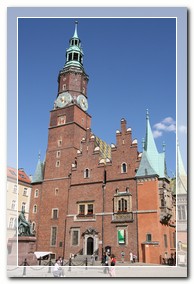
 he late-gothic Wroclaw's town hall is one of
the most beautiful and the best preserved in Poland. The works over it
began in the years 50’ of the XIII century and it was finished in the
XVI century. At the beginning it was a larger quantity of buildings and
annexes, joint after some time. The old judicial room made in a
Romanesque style is the oldest part of the town hall.
he late-gothic Wroclaw's town hall is one of
the most beautiful and the best preserved in Poland. The works over it
began in the years 50’ of the XIII century and it was finished in the
XVI century. At the beginning it was a larger quantity of buildings and
annexes, joint after some time. The old judicial room made in a
Romanesque style is the oldest part of the town hall.
On the eastern elevation, on the side of the pillory, the sight is
decorated with a beautifully adorned mediaeval astronomical quadrant,
the bay window of the chapel and the former main entry to the town hall
that deserves a special attention. The bas-relief on the portal
represents three elements of its present crest (to see at the presently
used entry on the western elevation). 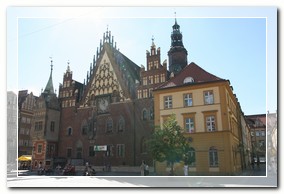 These are the symbols of the
changes of the national membership of the city — the Silesian eagle can
be seen on the portal next to the Czech lion of a double tail, while
over them the head of saint John Baptist reigns, the patron of the
Cathedral and the city. Many Citizens of Wroclaw tell a legend about
this entry and the fat low wall on its both sides, which is really
related to the previous building, the older town hall: they say that
near its entry two lovers were walled up alive, who had broken the vows
of purity because of love and were sentenced to this horrible death.
These are the symbols of the
changes of the national membership of the city — the Silesian eagle can
be seen on the portal next to the Czech lion of a double tail, while
over them the head of saint John Baptist reigns, the patron of the
Cathedral and the city. Many Citizens of Wroclaw tell a legend about
this entry and the fat low wall on its both sides, which is really
related to the previous building, the older town hall: they say that
near its entry two lovers were walled up alive, who had broken the vows
of purity because of love and were sentenced to this horrible death.
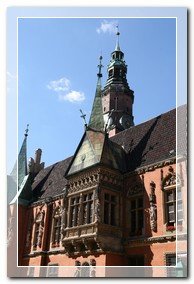 The southern elevation, the
richest and the most frequently bringing astonishment among tourists,
adorn three bay windows with an impressive late-gothic masonry. Rich
townspeople paid fortunes so that their faces were on the sculptures
adorning bay windows. It is worth to pay attention to the entry to the
Swidnicka Cellar situated below. In the Middle Ages a beer pub of this
name already existed in the undergrounds of town hall, and served an
excellent beer imported from Swidnica, a city near Wrocław. The present
restaurant in the cellars of the Town hall is the oldest restaurant in
Europe. Its history makes an impression — the first kept bills for beer
come from 1322! The cellar quickly began to produce its own beer of the
name White ram, which pushed out the beer of Swidnica, supposedly worse
then the one from Wroclaw. It was brew in the backyard of the tenement
"Under the gold pitcher" situated opposite the entrance to the Swidnicka
Cellar,
The southern elevation, the
richest and the most frequently bringing astonishment among tourists,
adorn three bay windows with an impressive late-gothic masonry. Rich
townspeople paid fortunes so that their faces were on the sculptures
adorning bay windows. It is worth to pay attention to the entry to the
Swidnicka Cellar situated below. In the Middle Ages a beer pub of this
name already existed in the undergrounds of town hall, and served an
excellent beer imported from Swidnica, a city near Wrocław. The present
restaurant in the cellars of the Town hall is the oldest restaurant in
Europe. Its history makes an impression — the first kept bills for beer
come from 1322! The cellar quickly began to produce its own beer of the
name White ram, which pushed out the beer of Swidnica, supposedly worse
then the one from Wroclaw. It was brew in the backyard of the tenement
"Under the gold pitcher" situated opposite the entrance to the Swidnicka
Cellar, 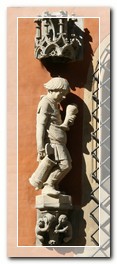
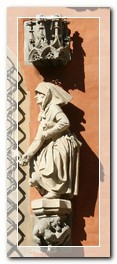 and transported to the beer pub through an
underground tunnel, so noises did not disturb the quiet of the venerable
occupants of neighboring houses. This tunnel just makes up the answer on
a famous Wroclaw's riddle: "where in Wroclaw can a cart drive by on a
cart?". Probably as a warning on both sides of the entry to the pub a
generic scene was put - on the left a husband with a pitcher, clearly
squiffy, returns home zigzag, on the right meanwhile his waiting for him
wife with a harsh face already prepares a slipper.
and transported to the beer pub through an
underground tunnel, so noises did not disturb the quiet of the venerable
occupants of neighboring houses. This tunnel just makes up the answer on
a famous Wroclaw's riddle: "where in Wroclaw can a cart drive by on a
cart?". Probably as a warning on both sides of the entry to the pub a
generic scene was put - on the left a husband with a pitcher, clearly
squiffy, returns home zigzag, on the right meanwhile his waiting for him
wife with a harsh face already prepares a slipper.
The western elevation preserved its strict, mediaeval character. On this side we can see the present entrance to the town hall and to the Municipal Museum, over which one can admire the new crest of Wroclaw. In the north-western corner adhering to the considerably later, neo-gothic part of Town Hall one can admire the 67 metres high tower, covered with a Renaissance helmet. There is the oldest clock bell in Poland dated on 1368.
















